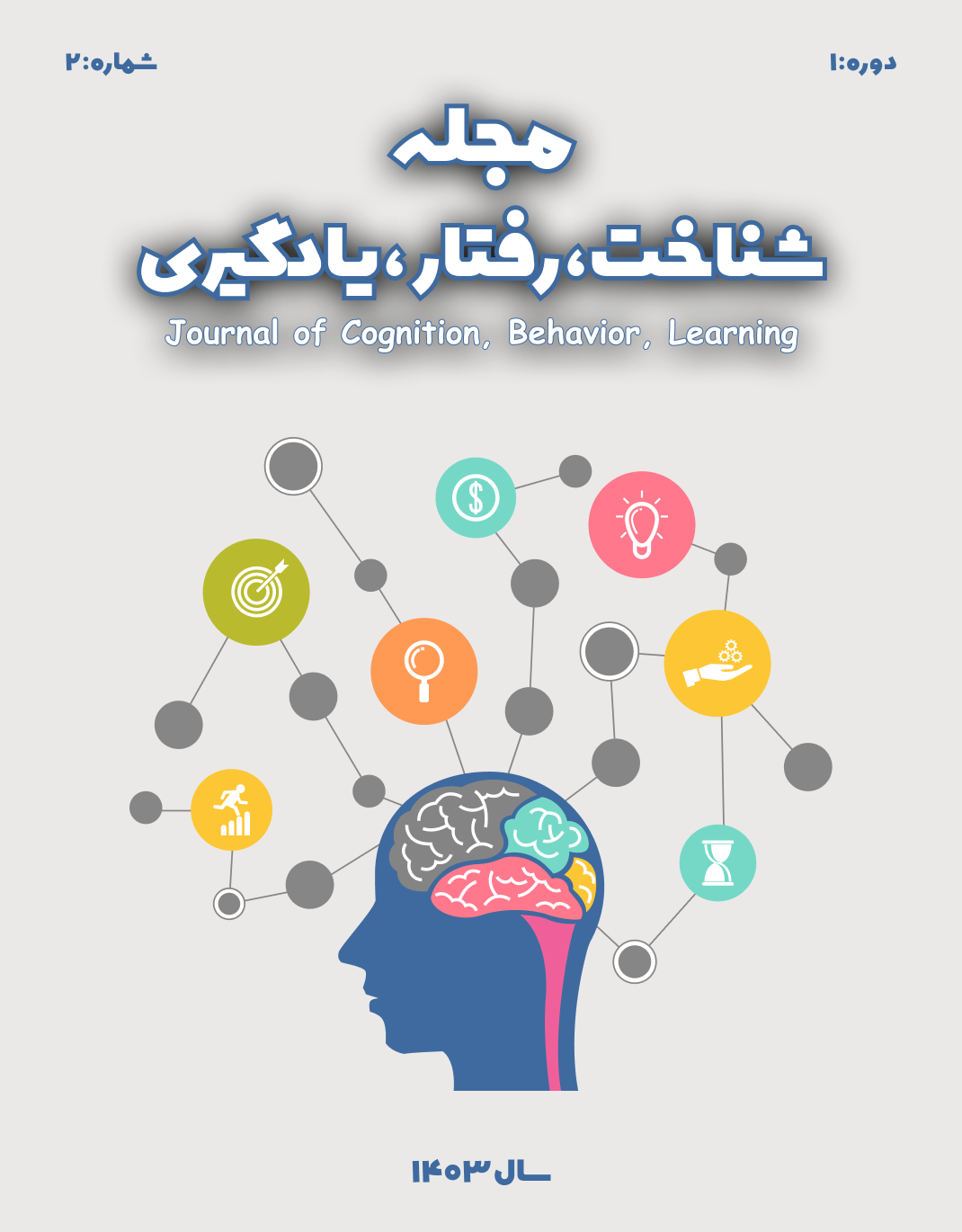Structural Model of Predicting Suicidal Thoughts in Adolescents Based on Defense Mechanisms with the Mediating Role of Emotional and Interpersonal Difficulties
Keywords:
Emotion regulation, Suicide, Interpersonal difficulty, Defense mechanismsAbstract
The aim of the present study was to determine the structural model of predicting suicidal thoughts in adolescents based on defense mechanisms with the mediating role of emotional and interpersonal difficulties. This research employed a descriptive-correlational design, and the statistical population consisted of all adolescents in Tehran during the second semester of the 2023–2024 academic year. A total of 443 individuals were selected through convenience sampling. Research instruments included the Defense Style Questionnaire-40 (Andrews, Singh, & Bond, 1993), the Difficulties in Emotion Regulation Scale (Gratz & Roemer, 2004), the Inventory of Interpersonal Problems-47 (Pilkonis, Kim, Proietti, & Barkham, 1996), and the Suicidal Cognitions Scale (Rudd et al., 2010). Data were analyzed using structural equation modeling. In this study, the indirect path coefficient between mature defense mechanisms and suicidal thoughts (β = -0.339, p = .01), and between immature defense mechanisms and suicidal thoughts (β = 0.255, p = .01), was statistically significant at the .01 level. Therefore, suicidal thoughts in adolescents can be predicted based on defense mechanisms, considering the mediating role of emotional and interpersonal difficulties.
Downloads
References
Aftab, R. (2016). The mediating role of interpersonal difficulties in the relationship between experiential avoidance and depression and anxiety. Journal of Applied Psychology, 10(40), 521-540. https://apsy.sbu.ac.ir/article_96757.html
Aftab, R., Barmas, H., & Abolmaali Hoseini, K. (2019). Predicting suicidal thoughts based on the five-factor personality traits with the mediation of defense mechanisms. Journal of Clinical Psychology, 11(43), 11-24. https://jcp.semnan.ac.ir/article_4166_0.html
Aftab, R., Taghilo, S., & Karbalaei Mohammad Meigoni, A. (2016). Structural model of relationships between borderline personality traits, interpersonal difficulties, and internet addiction. Journal of Psychological Achievements, 23(2), 113-136. https://psychac.scu.ac.ir/article_12583_1451.html
Babl, A., Grosse Holtforth, M., Perry, J. C., Schneider, N., Dommann, E., Heer, S., Stähli, A., Aeschbacher, N., Eggel, M., Eggenberg, J., Sonntag, M., Berger, T., & Caspar, F. (2019). Comparison and change of defense mechanisms over the course of psychotherapy in patients with depression or anxiety disorder: Evidence from a randomized controlled trial. Journal of affective disorders, 252, 212-220. https://doi.org/10.1016/j.jad.2019.04.021
Baumeister, R. F. (1990). Suicide as escape from self. Psychological review, 97(1), 90-113. https://doi.org/10.1037/0033-295X.97.1.90
Berney, S., de Roten, Y., Beretta, V., Kramer, U., & Despland, J. N. (2014). Identifying psychotic defenses in a clinical interview. Journal of Clinical Psychology, 70(5), 428-439. https://doi.org/10.1002/jclp.22087
Besharat, M. A., Afghah, Z., Aghaei Sabat, S., Habibnezhad, M., Pournaghdali, A., & Granmayehpour, S. (2013). The moderating role of cognitive emotional regulation strategies in the relationship between alexithymia and interpersonal problems. Cognitive Sciences, 15(4), 43-52. https://doi.org/10.5539/ijps.v5n4p60
Brodie, Z. P., Goodall, K., Darling, S., & McVittie, C. (2019). Attachment insecurity and dispositional aggression: The mediating role of maladaptive anger regulation. Journal of Social and Personal Relationships, 36(6), 1831-1852. https://doi.org/10.1177/0265407518772937
Brook, C. A., & Schmidt, L. A. (2020). Lifespan trends in sociability: Measurement invariance and mean-level differences in ages 3 to 86 years. Personality and individual differences, 152, 109579. https://doi.org/10.1016/j.paid.2019.109579
Butler, R. M., Boden, M. T., Olino, T. M., Morrison, A. S., Goldin, P. R., Gross, J. J., & Heimberg, R. G. (2018). Emotional clarity and attention to emotions in cognitive behavioral group therapy and mindfulness-based stress reduction for social anxiety disorder. Journal of anxiety disorders, 55, 31-38. https://doi.org/10.1016/j.janxdis.2018.03.003
Ciocca, G., Collazzoni, A., Limoncin, E., Franchi, C., Mollaioli, D., Di Lorenzo, G., & Jannini, E. A. (2017). Defence mechanisms and attachment styles in paranoid ideation evaluated in a sample of non-clinical young adults. Rivista di Psichiatria, 52(4), 162-167. https://www.rivistadipsichiatria.it/archivio/2737/articoli/27909/
Clarkin, J. F., Yeomans, F. E., & Kernberg, O. F. (2015). Transference-focused psychotherapy for borderline personality disorder: A clinical guide. American Psychiatric Publication. https://doi.org/10.1176/appi.books.9781615371006
Coats, A. H., & Blanchard-Fields, F. (2008). Emotion regulation in interpersonal problems: the role of cognitive-emotional complexity, emotion regulation goals, and expressivity. Psychology and Aging, 23(1), 39-51. https://doi.org/10.1037/0882-7974.23.1.39
Cramer, P. (2002). Defense mechanisms, behavior, and affect in young adulthood. Journal of personality, 70(1), 103-126. https://doi.org/10.1111/1467-6494.00180
Cramer, P. (2006). Protecting the self: Defense mechanisms in action. Guilford Press. https://psycnet.apa.org/record/2006-08215-000
Cramer, P. (2012). Psychological maturity and change in adult defense mechanisms. Journal of research in personality, 46(3), 306-316. https://doi.org/10.1016/j.jrp.2012.02.011
Diehl, M., Chui, H., Hay, E. L., Lumley, M. A., Grühn, D., & Labouvie-Vief, G. (2014). Change in coping and defense mechanisms across adulthood: longitudinal findings in a European American sample. Developmental Psychology, 50(2), 634-648. https://doi.org/10.1037/a0033619
Fraley, R. C., & Roisman, G. I. (2019). The development of adult attachment styles: four lessons. Current opinion in psychology, 25, 26-30. https://doi.org/10.1016/j.copsyc.2018.02.008
Gillath, O., Karantzas, G. C., & Fraley, R. C. (2016). Adult attachment: A concise introduction to theory and research. Academic Press. https://doi.org/10.1016/B978-0-12-420020-3.00001-3
Granieri, A., La Marca, L., Mannino, G., Giunta, S., Guglielmucci, F., & Schimmenti, A. (2017). The relationship between defense patterns and DSM-5 maladaptive personality domains. Frontiers in Psychology. https://doi.org/10.3389/fpsyg.2017.01926
Gratz, K. L., & Roemer, L. (2004). Multidimensional assessment of emotion regulation and dysregulation: development, factor structure, and initial validation of the Difficulties in Emotion Regulation Scale. Journal of psychopathology and behavioral assessment, 26(1), 41-55. https://doi.org/10.1023/B:JOBA.0000007455.08539.94
Gvion, Y., & Levi-Belz, Y. (2018). Serious suicide attempts: Systematic review of psychological risk factors. Frontiers in Psychiatry, 9, 56. https://doi.org/10.3389/fpsyt.2018.00056
Hagger, M. S., Wood, C., Stiff, C., & Chatzisarantis, N. L. (2010). Ego depletion and the strength model of self-control: a meta-analysis. Psychological bulletin, 136(4), 495-525. https://doi.org/10.1037/a0019486
Herr, N. R., Rosenthal, M. Z., Geiger, P., & Erikson, K. (2013). Difficulties with emotion regulation mediate the relationship between borderline personality disorder symptom severity and interpersonal problems. Personality and Mental Health, 7(3), 191-202. https://doi.org/10.1002/pmh.1204
Hilt, L. M., Hanson, J. L., & Pollak, S. D. (2011). Emotion Dysregulation. In Encyclopedia of Adolescence (pp. 160-169). https://doi.org/10.1016/B978-0-12-373951-3.00112-5
Huprich, S. K. (2015). Personality Disorders: Toward Theoretical and Empirical Integration in Diagnosis and Assessment. American Psychological Association. https://doi.org/10.1037/14549-000
Iskric, A., Ceniti, A. K., Bergmans, Y., McInerney, S., & Rizvi, S. J. (2020). Alexithymia and Self-Harm: A review of Nonsuicidal Self-Injury, Suicidal Ideation, and Suicide Attempts. Psychiatry research, 112920. https://doi.org/10.1016/j.psychres.2020.112920
Joiner, T. E. (2005). Why people die by suicide. Harvard University Press. https://www.jstor.org/stable/j.ctvjghv2f
Joyce, A. S., Stovel, L. E., Ogrodniczuk, J. S., & Fujiwara, E. (2013). Defense style as a predictor of change in interpersonal problems among patients attending day treatment for personality disorder. Psychodynamic Psychiatry, 41(4), 597-617. https://doi.org/10.1521/pdps.2013.41.4.597
Jun, J. Y., Lee, Y. J. G., Lee, S. H., Yoo, S. Y., Song, J., & Kim, S. J. (2015). Association between defense mechanisms and psychiatric symptoms in North Korean Refugees. Comprehensive Psychiatry, 56, 179-187. https://doi.org/10.1016/j.comppsych.2014.10.001
Kachooei, M., Veis, P., & Soozi, R. (2014). Comparison of defense styles and personality traits in non-depressed and depressed individuals referred to treatment centers affiliated with the University of Social Welfare and Rehabilitation Sciences. Journal of Medical Sciences, 24(3), 182-188. https://www.cabidigitallibrary.org/doi/full/10.5555/20153030136
Karreman, A., & Vingerhoets, A. (2012). Attachment and well-being: The mediating role of emotion regulation and resilience. Personality and individual differences, 53, 821-826. https://doi.org/10.1016/j.paid.2012.06.014
Kernberg, O. F. (2004). Borderline personality disorder and borderline personality organization: Psychopathology and psychotherapy. In Handbook of Personality Disorders: Theory and Practice (pp. 92-119). https://www.al-edu.com/wp-content/uploads/2014/05/Magnavita-ed-Handbook-of-Personality-Disorders-Theory-and-Practice.pdf#page=110
Khanzadeh, M., Saeedian, M., Hosseini Chari, M., & Idrisi, F. (2012). Factor structure and psychometric properties of the emotional regulation difficulties scale. Journal of Behavioral Sciences, 6(1), 87-96. https://www.behavsci.ir/article_67768_01a5f82ae30d4cbf3dd322fd6618c7eb.pdf
Kulkarni, M., Porter, K. E., & Rauch, S. A. (2012). Anger, dissociation, and PTSD among male veterans entering into PTSD treatment. Journal of anxiety disorders, 26(2), 271-278. https://doi.org/10.1016/j.janxdis.2011.12.005
Levi-Belz, Y., Gvion, Y., Levi, U., & Apter, A. (2019). Beyond the mental pain: A case-control study on the contribution of schizoid personality disorder symptoms to medically serious suicide attempts. Comprehensive Psychiatry, 90, 102-109. https://doi.org/10.1016/j.comppsych.2019.02.005
Ma, J., Batterham, P. J., Calear, A. L., & Han, J. (2016). A systematic review of the predictions of the Interpersonal-Psychological Theory of Suicidal Behavior. Clinical psychology review, 46, 34-45. https://doi.org/10.1016/j.cpr.2016.04.008
Mahmoodnejad, M., Karbalaei Mohammad Meigoni, A., & Sabet, M. (2018). Predicting suicidal ideation and interpersonal violence in working children based on childhood trauma, emotional regulation difficulties, and callous-unemotional traits. Journal of Psychological Achievements, 25(1), 1-22. https://psychac.scu.ac.ir/author.index?vol=0&vl=%D9%87%D9%85%D9%87%20%D8%AF%D9%88%D8%B1%D9%87%20%D9%87%D8%A7
McCrae, R. R., & Costa, P. T. (2003). Personality in adulthood: A five-factor theory perspective. Guilford Press. https://doi.org/10.4324/9780203428412
McLean, J. (2007). Psychotherapy with a narcissistic patient using Kohut's self-psychology model. Psychiatry (Edgmont), 4(10), 40-47. https://pmc.ncbi.nlm.nih.gov/articles/PMC2860525/
Mohammadkhani, P., Abasi, I., Pourshahbaz, A., Mohammadi, A., & Fatehi, M. (2016). The role of neuroticism and experiential avoidance in predicting anxiety and depression symptoms: Mediating effect of emotion regulation. Iranian journal of psychiatry and behavioral sciences, 10(3), e5047. https://doi.org/10.17795/ijpbs-5047
Moore, S. D., Brody, L. R., & Dierberger, A. E. (2009). Mindfulness and experiential avoidance as predictors and outcomes of the narrative emotional disclosure task. Journal of Clinical Psychology, 65(9), 971-988. https://doi.org/10.1002/jclp.20600
Najafi, M., Hosseini Imam, S. S., Makvand Hosseini, S., Salavati, M., & Rezaei, A. M. (2019). Comparison of the effectiveness of emotion regulation skills training based on Gross and Linehan models on suicidal thoughts in adolescents with borderline personality disorder. Journal of Psychological Studies, 15(54), 131-146. https://psychstudies.alzahra.ac.ir/author.index?vol=0&vl=%D9%87%D9%85%D9%87%20%D8%AF%D9%88%D8%B1%D9%87%20%D9%87%D8%A7
Pearlman, L. A. (1997). Trauma and the Self. Journal of Emotional Abuse, 1(1), 7-25. https://doi.org/10.1300/J135v01n01_02
Pilkonis, P. A., Kim, Y., Proietti, J. M., & Barkham, M. (1996). Scales for personality disorders developed from the inventory of interpersonal problems. Journal of personality disorders, 10(4), 355-369. https://doi.org/10.1521/pedi.1996.10.4.355
Predatu, R., David, D. O., & Maffei, A. (2020). The effects of irrational, rational, and acceptance beliefs about emotions on the emotional response and perceived control of emotions. Personality and individual differences, 155, 109712. https://doi.org/10.1016/j.paid.2019.109712
Prout, T. A., Malone, A., Rice, T. R., & Hoffman, L. (2019). Resilience, Defense Mechanisms, and Implicit Emotion Regulation in Psychodynamic Child Psychotherapy. Journal of Contemporary Psychotherapy, 49(4), 235-244. https://doi.org/10.1007/s10879-019-09423-w
Puhalla, A. A., McCloskey, M. S., Brickman, L. J., Fauber, R., & Coccaro, E. F. (2016). Defense styles in Intermittent Explosive Disorder. Psychiatry research, 238, 137-142. https://doi.org/10.1016/j.psychres.2016.02.019
Rajalin, M., Hirvikoski, T., Salander Renberg, E., Åsberg, M., & Jokinen, J. (2017). Family history of suicide and interpersonal functioning in suicide attempters. Psychiatry research, 247, 310-314. https://doi.org/10.1016/j.psychres.2016.11.029
Rajappa, K., Gallagher, M., & Miranda, R. (2012). Emotion dysregulation and vulnerability to suicidal ideation and attempts. Cognitive therapy and research, 36(6), 833-839. https://doi.org/10.1007/s10608-011-9419-2
Rice, T. R., & Hoffman, L. (2014). Defense mechanisms and implicit emotion regulation: A comparison of a psychodynamic construct with one from contemporary neuroscience. Journal of the American Psychoanalytic Association, 62(4), 693-708. https://doi.org/10.1177/0003065114546746
Rubenstein, L. M., Hamilton, J. L., Stange, J. P., Flynn, M., Abramson, L. Y., & Alloy, L. B. (2015). The cyclical nature of depressed mood and future risk: Depression, rumination, and deficits in emotional clarity in adolescent girls. Journal of adolescence, 42, 68-76. https://doi.org/10.1016/j.adolescence.2015.03.015
Scheepers, F. E., de Mul, J., Boer, F., & Hoogendijk, W. J. (2018). Psychosis as an evolutionary adaptive mechanism to changing environments. Frontiers in Psychiatry, 9, 237. https://doi.org/10.3389/fpsyt.2018.00237
Set, Z. (2019). Potential regulatory elements between attachment styles and psychopathology: rejection sensitivity and self-esteem. Nöro Psikiyatri Arşivi, 56(3), 205-212. https://doi.org/10.29399/npa.23451
Steare, T., Lewis, G., Evans-Lacko, S., Pitman, A., Rose-Clarke, K., & Patalay, P. (2024). Food Insecurity, Adolescent Suicidal Thoughts and Behaviors, and Country-Level Context: A Multi-Country Cross-Sectional Analysis. Journal of Adolescent Health, 74(3), 545-555. https://doi.org/10.1016/j.jadohealth.2023.10.018
Stepp, S. D., Morse, J. Q., Yaggi, K. E., Reynolds, S. K., Reed, L. I., & Pilkonis, P. A. (2008). The role of attachment styles and interpersonal problems in suicide-related behaviors. Suicide & Life-Threatening Behavior, 38(5), 592-607. https://doi.org/10.1521/suli.2008.38.5.592
Sun, J., Ban, Y., & Liu, J. (2024). Relationship between bullying victimization and suicide ideation among Chinese adolescents: A moderated chain mediation model. Children and Youth Services Review, 156, 107304. https://doi.org/10.1016/j.childyouth.2023.107304
Tasca, G. A. (2014). Attachment and group psychotherapy: Introduction to a special section. Psychotherapy, 51, 53-56. https://doi.org/10.1037/a0033015
Vaillant, G. E. (1994). Ego mechanisms of defense and personality psychopathology. Journal of abnormal psychology, 103(1), 44-50. https://doi.org/10.1037/0021-843X.103.1.44
Vaillant, G. E. (2012). Defense Mechanisms. In Encyclopedia of Human Behavior (pp. 659-666). https://doi.org/10.1016/B978-0-12-375000-6.00124-5
Vanwoerden, S., Kalpakci, A. H., & Sharp, C. (2015). Experiential avoidance mediates the link between maternal attachment style and theory of mind. Comprehensive Psychiatry, 57, 117-124. https://doi.org/10.1016/j.comppsych.2014.11.015
Vargas-Medrano, J., Diaz-Pacheco, V., Castaneda, C., Miranda-Arango, M., Longhurst, M. O., Martin, S. L., Ghumman, U., Mangadu, T., Chheda, S., Thompson, P. M., & Gadad, B. S. (2020). Psychological and neurobiological aspects of suicide in adolescents: Current outlooks. Brain, Behavior, & Immunity - Health, 7, 100124. https://doi.org/10.1016/j.bbih.2020.100124
Zalpour, K., Shahidi, S., Zarani, F., Mazaheri, M. A., & Heidari, M. (2016). Comparison of interpersonal problems and aggression in students with grandiose, vulnerable, and non-narcissistic tendencies. Journal of Clinical Psychology Studies, 6(22), 1-18. https://japr.ut.ac.ir/article_86393.html
Zandi, S., Shahabinejad, Z., & Borhan, A. (2017). Predicting different levels of defense mechanisms based on the big five personality traits in students. Zanco Journal of Medical Sciences, 18(56), 21-32. https://zanko.muk.ac.ir/article-1-166-fa.html
Zemestani, M., Yousefi, N., & Keshavarzi, S. (2015). The effectiveness of group cognitive-behavioral therapy with family education on components related to suicide in suicidal girls. Family Counseling and Psychotherapy Quarterly, 5(19), 107-120. https://japr.ut.ac.ir/article_86393.html
Downloads
Published
Submitted
Revised
Accepted
Issue
Section
License
Copyright (c) 2024 Journal of Cognition, Behavior, Learning

This work is licensed under a Creative Commons Attribution-NonCommercial 4.0 International License.






